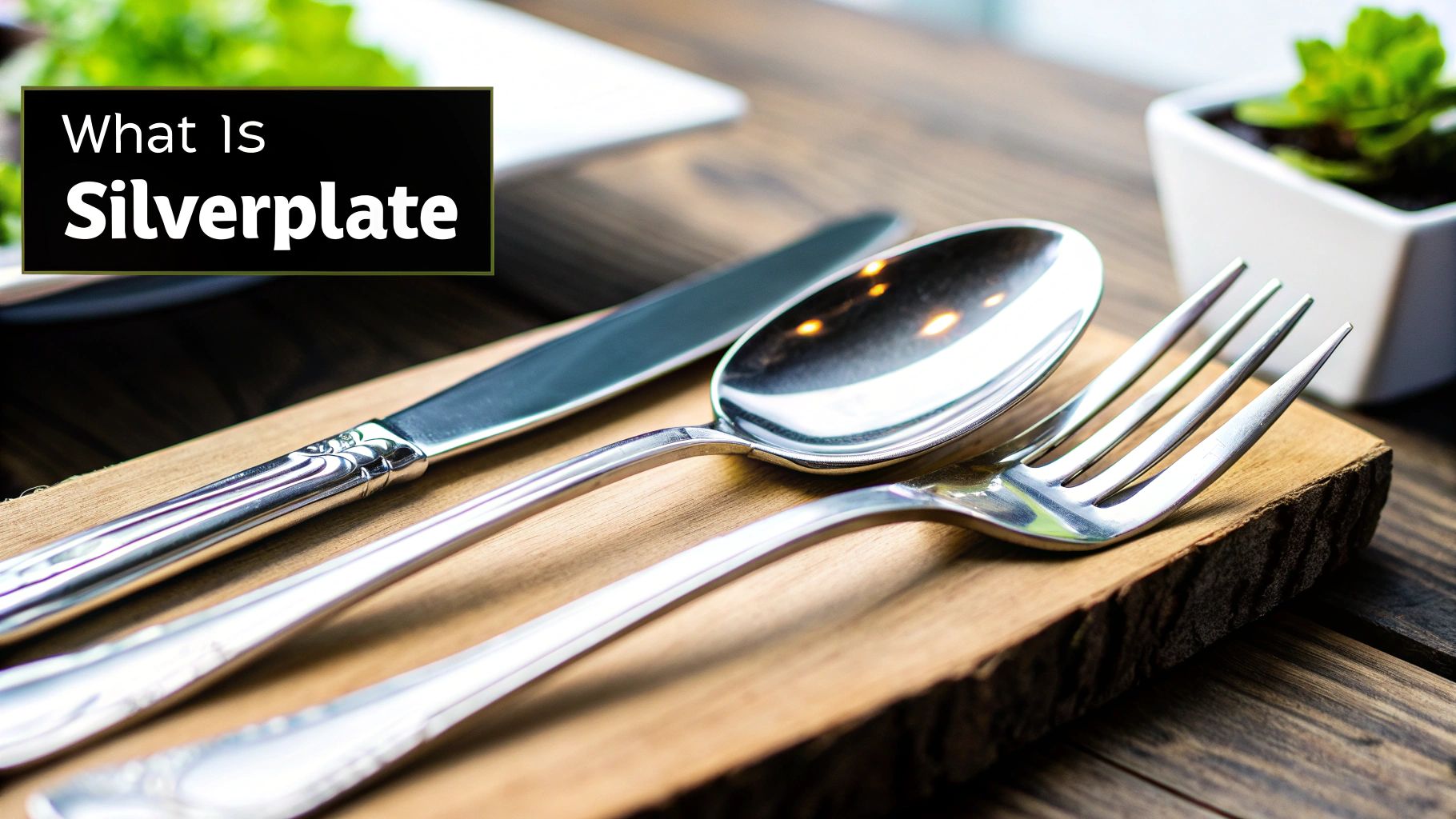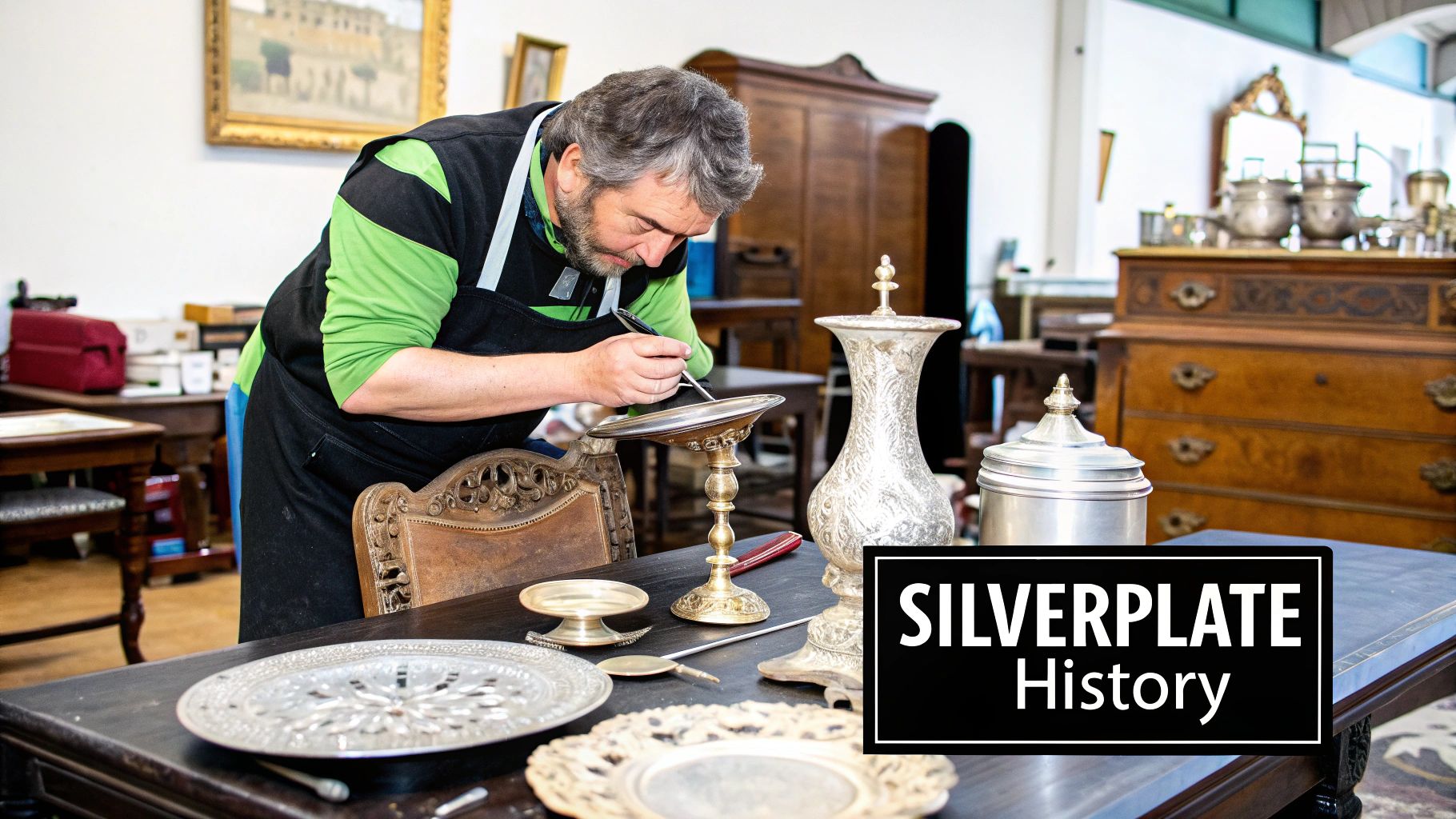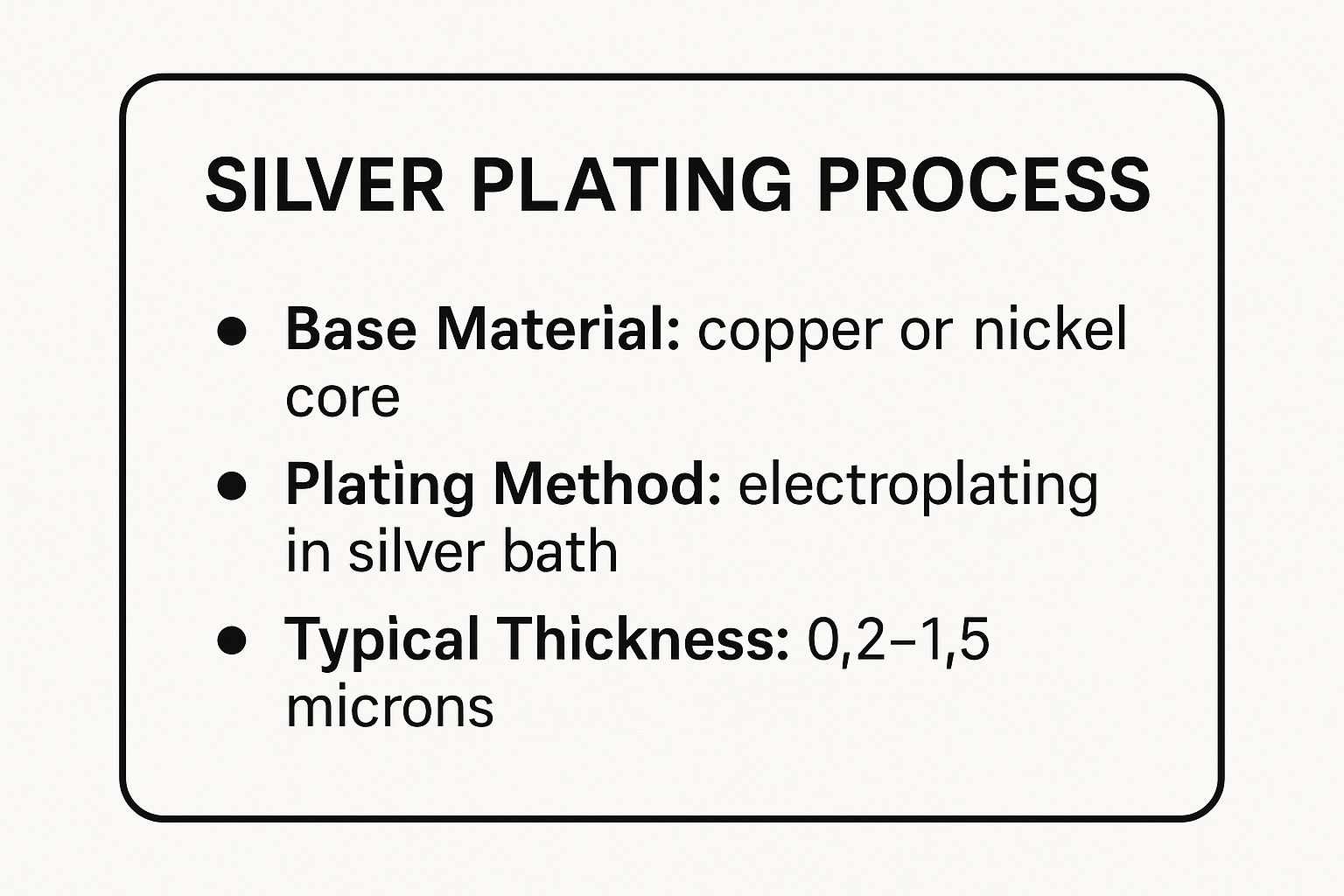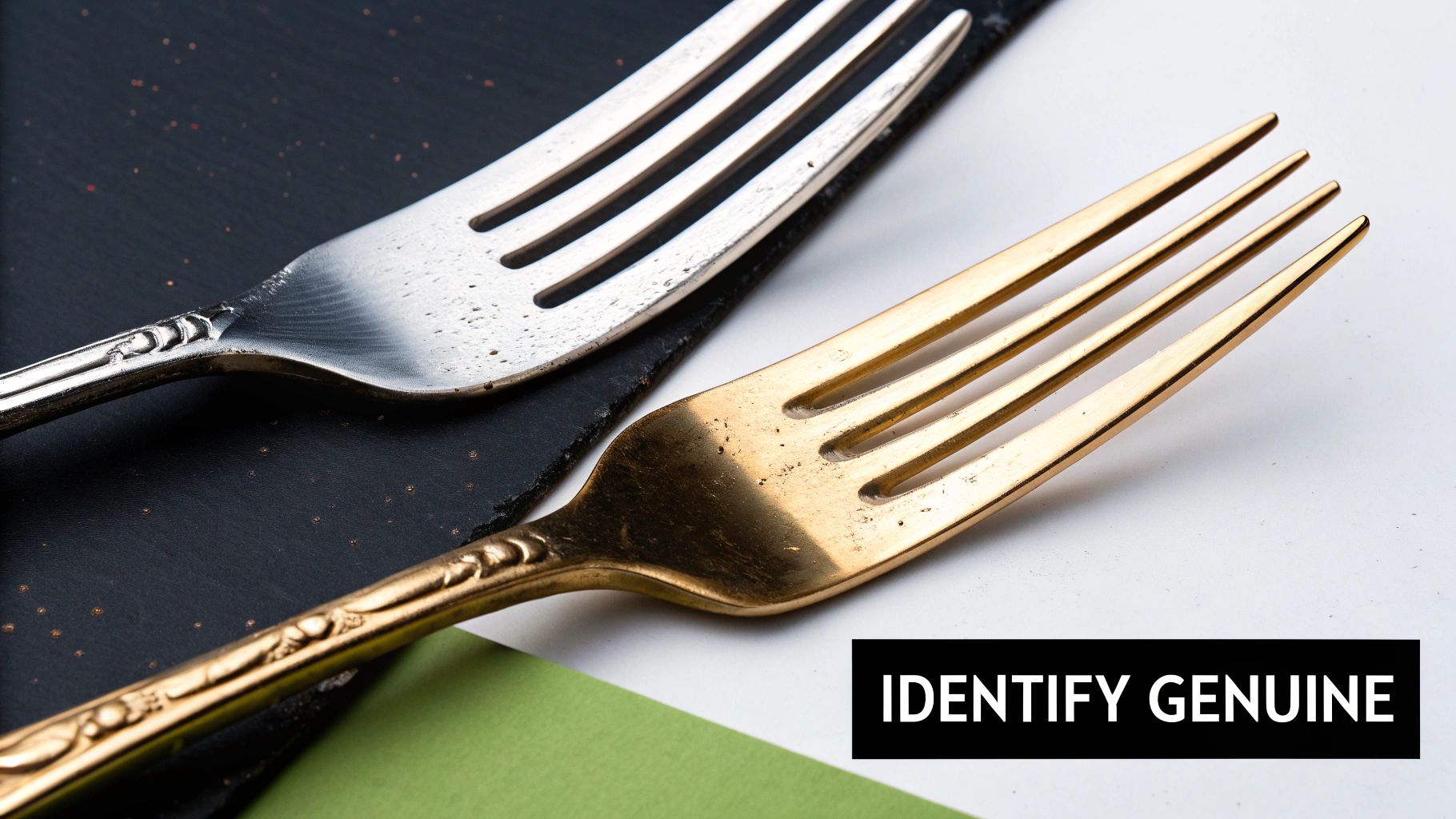What Is Silverplate? Understanding The Basics

To truly appreciate silverplate, it's important to understand what is silverplate and the reasons it became a prominent feature in many homes. Simply put, silverplate describes items not crafted from solid silver. Instead, they have a layer of pure silver carefully bonded to a more common, less costly base metal, making silver's beauty more widely attainable.
The Magic of Electroplating
The technique used to create silverplate is called electroplating. Think of it as giving an ordinary metal object a luxurious silver coating. During this process, an item made from a base metal like copper, brass, or nickel silver (an alloy combining copper, nickel, and zinc) is immersed in a special bath containing silver ions. An electric current is then introduced, causing these silver ions to adhere evenly to the surface of the base metal item.
This careful procedure turns common metals into pieces that have the splendid look of genuine silver. The thickness of this silver coating is a crucial detail affecting the item's resilience and worth. Generally, a thicker plating results in a longer-lasting shine and greater resistance to wear and tear. For instance, a serving spoon with substantial plating might endure daily use for many years, whereas a thinly plated decorative piece could show wear more readily if handled often.
Base Metals and Their Impact
The type of base metal chosen plays a big part in the final quality and attributes of a silverplate piece. Some frequently used base metals are:
- Copper: Often selected because it is easy to shape and silver adheres well to it. If the silver layer wears down, a reddish tint might sometimes show through.
- Brass: This alloy of copper and zinc offers a strong and corrosion-resistant foundation.
- Nickel Silver: Also known as German Silver, this alloy provides a tough, silver-white base. Even if the plating wears, it doesn't create a jarring color difference, often signaling a higher-quality item.
- Britannia Metal: A pewter-like alloy, it was a popular choice in the 19th century and served as a good base for silver plating.
Knowing about these base metals can help you judge how long a piece might last. The concept of silverplate grew particularly significant with the rise of mass production and industrial advancements in the late 19th and early 20th centuries. A noteworthy historical point is the global surge in silver production between 1876 and 1920. During this era, annual output jumped from approximately 40–60 million ounces to around 190 million ounces each year. This increase directly boosted the availability of silver for such plating methods. You can discover more about silver supply and demand trends from the Silver Institute to understand its effect on manufacturing.
Identifying good quality silverplate involves checking for a consistent, smooth silver layer that isn't peeling or bubbling. The item's weight can also be a clue; pieces with a heavier base metal often feel more substantial and of better quality. This basic understanding is valuable whether you're considering buying your first silverplate dining set or assessing inherited items, enabling you to make well-informed choices.
How Silverplate Changed Everything For The Middle Class

The arrival of silverplate marked a significant shift, going beyond mere manufacturing progress to reshape societal norms and dreams. Suddenly, items possessing the look and feel of genuine solid silver were within reach of more than just the elite, a true democratization of luxury for the expanding middle class. This important change was significantly propelled by the innovations of the Industrial Revolution.
The Dawn of Accessible Elegance
Pioneering companies like the Rogers Brothers led the way, creating techniques to mass-produce refined tableware. Before this, possessing silverware was a distinct sign of considerable affluence. As factories started to efficiently make silver-plated items, everyday families found they could furnish their dining tables with pieces reflecting the elegance previously exclusive to the wealthy. This represented more than just new acquisitions; it marked a notable shift in social expectations concerning hosting and formal meals.
Being able to provide guests, or even one's own family, with a dining setting brightened by shiny "silver" established a new standard of middle-class decorum. This cultural transformation was greatly supported by a rise in the availability of raw materials. For instance, by the 1870s, yearly silver production had doubled compared to the preceding decade. This boom, driven by technological advancements such as steam-assisted drilling and better metallurgy, alongside new mineral finds, allowed for the processing of larger quantities of lower-grade silver ores. Consequently, this made the production of silverplate items more affordable. Discover more about how silver production influenced the industry.
Social Aspirations and Lasting Appeal
A powerful wish to mirror the lifestyles of the wealthier classes fueled a substantial demand for what is silverplate. Possessing these pieces turned into a clear sign of upward mobility and refined taste. Manufacturers whose names became associated with high standards, much like the early innovators, built legacies that have lasted through time.
This backdrop clarifies why numerous vintage silverplate items remain highly valued by collectors and interior enthusiasts. These are not merely old eating implements; they serve as concrete connections to an era of major social and economic change, embodying the ambitions of a past generation. The detailed work and styling of these items frequently mirror the artistic tastes of their period, which further increases their appeal.
Silverplate Vs Sterling Silver: What You Really Need To Know
When you're browsing antique markets or assessing family heirlooms, a common puzzle arises: are you looking at silverplate or sterling silver? Distinguishing between them is more than just satisfying curiosity; it directly affects the item's value, the care it requires, and how you might use these often beautiful pieces. Understanding what is silverplate compared to solid sterling silver can help you avoid expensive errors and make informed purchases.
Decoding the Marks: Hallmarks and Stamps
The most dependable method for telling the two apart often comes down to the small inscriptions, known as hallmarks, on the items. Sterling silver pieces are usually stamped with terms such as "Sterling," "STER," or numbers like "925" or "92.5." These indicate a 92.5% pure silver content and serve as a guarantee of the silver's purity.
Silverplate, conversely, will carry different markings. You should look for inscriptions like:
- "EPNS" (which stands for Electro Plated Nickel Silver)
- "EPBM" (meaning Electro Plated Britannia Metal)
- "A1" or "AA" (these often signify a higher quality of plating)
- Manufacturer's names accompanied by "Plate" (for example, "Rogers Bros. Plate") These marks clearly show that the piece has a silver coating over a base metal, a defining characteristic of what is silverplate.
Key Differences at a Glance
While hallmarks provide straightforward clues, grasping the basic differences in their makeup, worth, and resilience is key. To clarify these distinctions, the following table offers a detailed comparison of composition, pricing, durability, and identifying features between silverplate and sterling silver items.
Silverplate vs Sterling Silver Comparison
| Feature | Silverplate | Sterling Silver |
|---|---|---|
| Composition | A base metal (like copper or nickel) with a thin layer of pure silver applied via electroplating. | An alloy made of 92.5% pure silver and 7.5% other metals (commonly copper) for added strength. |
| Identifying Marks | "EPNS," "Plate," "A1," manufacturer names (e.g., Rogers Bros. Plate). Lacks a universal purity mark. | "Sterling," "STER," "925," "925/1000." May include a Lion passant mark (common in the UK). |
| Typical Pricing | Generally lower; value is often based on the craftsmanship, maker, condition, and design intricacy. | Typically higher; value is primarily determined by silver weight (current market value) and craftsmanship. |
| Durability | Varies depending on the thickness of the plating. Susceptible to wear, which can expose the base metal over time with frequent use or polishing. | Highly durable. It can be scratched, but it is solid silver throughout. Scratches can often be polished out. |
| Maintenance | Requires polishing. Gentle cleaning is crucial to protect the thin silver layer. Abrasive polishes should be avoided. | Requires polishing. Generally more tolerant of thorough cleaning, though care is still necessary. |
This comparison underscores why sterling silver typically fetches higher prices; its value is directly linked to its significant silver content. In contrast, the worth of silverplate items frequently depends more on the artistry, the reputation of the maker, and its current condition. For example, an elaborately designed Victorian silverplate teapot might be valued for its craftsmanship, even with minimal silver content. Silver is often combined with other materials for visual appeal, as seen in items like the Scandinavian Defense Art Deco black and silver metallic chess set, which blends aesthetics with practical use.
The infographic presented below outlines the main stages in the silverplating manufacturing process, showing the base materials, the plating technique, and the usual silver thickness.

This visual explains how a core material, such as copper or nickel, is coated with a fine layer of silver through electroplating, typically ranging from 0.2 to 1.5 microns in thickness.
Everyday Use and Care Considerations
When considering items for daily use, practicality might guide your decision. Sterling silver's sturdiness means that scratches can often be buffed out. However, silverplate durability depends heavily on the plating's thickness and quality. Good quality, thickly plated pieces can withstand regular use if handled carefully, making them an excellent option for attractive yet more budget-friendly tableware.
Both silverplate and sterling silver need regular polishing to prevent tarnish. While some individuals use their sterling silver daily and even clean it in a dishwasher (with non-citrus detergents), this approach is generally more hazardous for silverplate. Aggressive detergents and high heat can wear down the thin silver layer or harm delicate parts. Gentle handwashing is typically the most prudent method to keep your silverplate items in good condition for many years.
Why Global Silver Markets Matter For Your Collection
The shifting prices of silverplate items and the availability of specific vintage pieces are not random occurrences. They are frequently connected to the worldwide production of silver. Grasping these larger economic movements can greatly improve your understanding of what is silverplate and its market worth, affecting everything from new item costs to the valuation of your treasured antiques.
The Global Tapestry of Silver Production
The supply and cost of materials for silverplate are directly shaped by a few major countries. Globally, nations like Mexico, China, and Peru are the primary sources of silver. For example, in 2024, worldwide silver production totaled 25,000 metric tons. Mexico was the largest producer with 6,300 metric tons, China followed with 3,300 metric tons, and Peru added 3,100 metric tons to the global supply. You can find more detailed statistics here about global silver production.
These numbers show that events in these key producing countries—such as economic changes, new government policies, or mining developments—can send effects throughout the market. This impacts the silver supply chain, influencing both the creation of new silverplate and the restoration of older items.
This global supply situation means that the raw material for what is silverplate is influenced by international market conditions. An increase in mining output could result in lower silver prices, which might make new silverplate items more affordable. On the other hand, disruptions to the supply chain can drive up costs, which then affects manufacturers and, ultimately, people buying these goods. Silver is often combined with other metals in designs, such as in decorative items like this silver metallic chess set, and the price of such pieces can also mirror these raw material costs.
Market Dynamics and Your Collection's Value
These economic factors do more than just influence today's market; they also provide insight into the past. Some historical eras had abundant silver production, which sometimes happened at the same time as improvements in plating methods. This combination often led to higher-quality silverplate being made in larger amounts, and these pieces can be more valuable and sought after by collectors today.
Understanding these trends can help you make sense of:
- Pricing Patterns: Why the prices you see at auctions and in antique shops can change.
- Market Conditions: How to tell if it's a good time to buy or sell silverplate.
- Long-Term Value: The various elements that contribute to the lasting desirability and possible increase in value of certain silverplate items.
By getting a handle on how global silver markets function, you gain a distinct insight. This awareness not only aids in deciding when to buy or sell but also deepens your appreciation for the economic history behind each item in your collection, offering a clearer picture of what is silverplate within a larger economic framework.
Discovering Hidden Treasures In Your Silverplate Collection

That seemingly ordinary, tarnished serving tray or set of spoons tucked away in your attic might hold an interesting story and potentially more value than you imagine. Uncovering the history behind your silverplate pieces involves some investigative work. Learning to identify makers, date items, and understand market value can be a very satisfying experience. It's about appreciating what is silverplate not just for its shine, but for its heritage.
Uncovering The Story: Maker's Marks And Patterns
The initial step in evaluating any silverplate item is to look for manufacturer marks. These small stamps, often found on the underside or back of a piece, are like signatures that can tell you who made it. Well-known makers like Rogers Bros., Reed & Barton, or Oneida often have distinct marks.
Additionally, many silverplate items were produced in specific pattern names, such as "Vintage" by Rogers Bros. or "Reflection" by 1847 Rogers Bros. Identifying these can help determine the era of production and the piece's original setting.
Recognizing these details helps separate more sought-after pieces from common ones. For example:
- Look for letters like "EPNS" (Electro Plated Nickel Silver) or "EPBM" (Electro Plated Britannia Metal). These indicate the base metal used.
- Quality indicators such as "A1" or "Triple Plate" suggest a thicker, more durable silver coating, which is generally a positive sign.
- Monograms or unique engravings can sometimes add to the story and historical interest, though they may not always increase the monetary value.
What Influences Value In Silverplate?
Several factors contribute to the current market value of what is silverplate. Condition is extremely important; pieces with minimal wear to the plating, no dents, and intact details are typically more desirable. The maker and rarity of the pattern also play significant roles. Intricate or unusual designs from renowned manufacturers often command higher prices.
The historical context of production can also be relevant. In terms of statistical importance, the United States has been a key market for both silver and silverplate products. U.S. silver production has varied over time, reflecting broader market and technological trends. For example, in 1916, the U.S. reached an all-time high of 2,450 metric tons of silver production. This boom supported a flourishing silverware and plating industry, leading to many high-quality pieces from that era. You can find more details on U.S. silver production trends here.
Building Your Collection With Purpose
When evaluating your finds, it's important to have realistic expectations about valuation. While some silverplate pieces can be quite valuable, many are appreciated more for their aesthetic appeal and historical charm than for high monetary returns. Consider which items might be worth professional restoration; often, this is reserved for rare or exceptionally fine pieces.
Ultimately, the best strategy for building a silverplate collection is to focus on what brings you joy. Whether a piece appreciates in monetary value or not, its beauty, craftsmanship, and the stories it tells can be treasure enough. Understanding what is silverplate helps you appreciate these items for both their intrinsic qualities and their place in history.
Keeping Your Silverplate Beautiful For Years To Come
Ensuring your silverplate items retain their charm for many years requires a good grasp of their specific makeup. It's key to remember that silverplate consists of a fine coating of silver applied over a different base metal; this knowledge is central to its upkeep. Caring for silverplate properly isn't excessively difficult, but incorrect treatment can, regrettably, cause lasting harm.
Gentle Cleaning: The Golden Rule
The cornerstone of silverplate maintenance is a delicate touch. Forceful cleaning methods can erode the slender silver coating, revealing the underlying base metal. For regular cleaning and dealing with tarnish, choose a superior, non-abrasive silver polish, typically found as a cream or gel.
Here is a careful method to follow:
- Begin by washing the piece promptly in warm water using a gentle, phosphate-free dish soap to clear away any surface grime or food particles. Avoid prolonged soaking, which can be detrimental.
- Use a soft cloth or sponge to apply a modest quantity of silver polish, rubbing softly with linear, back-and-forth movements rather than circular ones.
- Wash off all polish residues thoroughly with fresh, warm water.
- Dry immediately and fully with a soft, lint-free cloth to avoid water marks. A useful tip from some specialists is to line the sink base with a terry cloth towel during washing to protect items from accidental bumps.
Harmful Practices To Sidestep
Some widely used cleaning techniques can actually harm your silverplate. It's crucial to avoid abrasive cleaners, scouring powders, or steel wool because these materials will scratch and remove the silver coating. Additionally, it's advisable to avoid detergents containing lemon or other citric acids, especially if considering dishwasher use, which is generally ill-advised.
The intense heat and strong detergents typical of most dishwashers can cause substantial damage to silverplate with repeated exposure. This can result in a lackluster, non-shiny finish or even make the plating flake off. Handwashing remains the most secure method for maintaining the appearance and worth of your items.
Addressing Wear And Embracing Character
Even with attentive handling, silverplate may eventually display evidence of use, like fine scratches or areas where the plating has become thin. Consistent, gentle polishing is vital for managing minor tarnish. For items that incur considerable wear or damage, seeking professional restoration can be a worthwhile consideration, especially for pieces of high value or deep sentimental meaning.
Nevertheless, there's also beauty in accepting the character that develops with age. Small flaws can narrate a history and enhance the appeal of older items. A practical care schedule that aligns with your way of life is the best approach to safeguard your collection, allowing your silverplate to continue gracing your settings with sophistication.
To keep your silverplate items looking their best, a consistent care routine is beneficial. The following table outlines a practical timeline with daily, weekly, and seasonal tasks designed to maintain your silverplate's optimal condition.
Silverplate Maintenance Schedule A practical timeline showing daily, weekly, and seasonal care tasks to keep silverplate items in optimal condition
| Frequency | Care Task | Purpose |
|---|---|---|
| Daily/After Each Use | Wash promptly with warm water and mild, phosphate-free dish soap. | To remove food residues and loose dirt, preventing buildup and potential reactions with the silver. |
| Daily/After Each Use | Dry immediately and thoroughly with a soft, lint-free cloth. | To prevent water spots and minimize the conditions favorable for tarnish formation. |
| Weekly/As Tarnish Appears | Gently polish with a non-abrasive silver polish. Use straight, back-and-forth motions, not circular. | To remove early signs of tarnish, restore shine, and maintain the silver layer's integrity without overuse. |
| Seasonal/Long-Term Storage | Store in a cool, dry place. Use tarnish-resistant cloths, bags, or acid-free tissue. Avoid contact with rubber or newspaper. | To protect from humidity, airborne sulfides, and materials that can accelerate tarnishing or cause damage. |
| As Needed | Inspect pieces for signs of excessive wear, deep scratches, or plating loss. | To identify any significant issues early, allowing for timely professional advice or restoration if desired. |
Adhering to this schedule helps ensure that minimal effort is needed for each cleaning session and that your silverplate remains a cherished part of your home for years. Regular, gentle care is far more effective than infrequent, aggressive cleaning, preserving the delicate silver layer for future enjoyment.
Smart Shopping Strategies For Silverplate Success
Starting your first silverplate collection, or simply looking for unique additions, becomes more rewarding when you navigate the market with a bit of know-how. Grasping what is silverplate beyond its immediate visual charm is crucial for acquiring items that promise enduring satisfaction, effectively merging aesthetic appeal with everyday practicality.
Spotting Quality And Authenticity
Finding genuine quality among the many choices available, whether you're browsing online, at estate sales, or in antique shops, calls for a keen eye. Valuable silverplate can range from sturdy pieces meant for daily use to elaborate serving sets that maintain their allure over time.
Always consider the weight and feel of an item; heavier pieces frequently suggest a more solid base metal and, possibly, a thicker layer of silver. Thanks to large-scale silver production, silverplate remains widely accessible, valued for its attractive combination of beauty and affordability. With the increase in global silver output, the variety and availability of silverplate items are also expanding, securing their place in homes and among collectors. You can explore this topic further through global silver statistics to understand more about production trends.
When you're assessing potential pieces, keep these pointers in mind:
- Examine Markings: Search for manufacturer stamps such as "EPNS," "A1," or the names of well-known makers. These marks can provide hints about the item's origin and the quality of the silverplate.
- Inspect the Plating: Look closely for an even coating, any indications of wear (particularly on edges and areas that get a lot of contact), and signs of peeling or bubbling. A finish that is smooth and uniform is what you're looking for.
- Assess Craftsmanship: Take note of the intricacy in the patterns, how handles or spouts are constructed, and the general finish. Pieces that are well-made usually show more attention to detail in their making.
- Research Prices: Compare prices of similar items from various sellers to establish a reasonable market value. The condition and rarity of a piece will heavily influence its cost.
Integrating Silverplate Into Modern Life
Figuring out how silverplate can be part of your life, whether for daily meals or special events, really comes down to the item's quality and your personal lifestyle. Certain sturdily plated pieces are tough enough for regular use, bringing a bit of elegance to your everyday dining.
On the other hand, more fragile or elaborately designed items are often best kept for formal occasions to keep them in top shape. Don't forget that proper storage is also key to looking after your collection. Making sure your silverplate is stored the right way, possibly in tidy display cabinets, helps it last longer. It's also important to regularly clean these storage areas; for instance, you can find useful tips on how to clean wood cabinets in specialized guides.
Ultimately, creating a silverplate collection is a personal journey that should match your individual style and financial plan. By developing an eye for quality and truly understanding what is silverplate, you'll be well-equipped to make informed decisions. These choices can elevate your dining moments and provide enjoyment for many years.
Discover a unique way to carry your cherished memories with Hidden Forever's exquisite projection photo jewelry. Each handcrafted piece beautifully conceals your special photo, revealed only when you choose. Explore the collection at Hidden Forever and create your timeless keepsake today!




